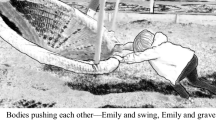Abstract
In this paper, I engage with arguments put forth by Anna Günther-Hanssen in her article “A swing and a child: How scientific phenomena can come to matter for preschool children’s emergent science identities.” Günther-Hanssen argues that new materialism can help us see how scientific phenomena can create affordances in becoming scientific and can also help us to better understand what “becoming scientific” means. Drawing on my own research with doctoral students in physics, I explore how the theoretical concepts presented in Günther-Hanssen’s paper, can be useful to investigate identity work at the doctoral level. I draw on empirical data from research conducted in Canada, to investigate the material-discursive entanglements that emerge in doctoral work, and the role that recognition plays in relation to these.



Similar content being viewed by others
References
Barad, K. (2003). Posthumanist performativity: Toward an understanding of how matter comes to matter. Signs: Journal of Women in Culture and Society, 28(3), 801–831. https://doi.org/10.1086/345321.
Barad, K. (2007). Meeting the universe halfway. Quantum physics and the entanglement of matter and meaning. Durham: Duke University Press.
Berg, A., & Lie, M. (1995). Feminism and constructivism: Do artifacts have gender? Science, Technology and Human Values, 20(3), 332–351. https://doi.org/10.1177/016224399502000304
Carlone, H. B., & Johnson, A. (2007). Understanding the science experiences of successful women of color: Science identity as an analytic lens. Journal of Research in Science Teaching, 44(8), 1187. https://doi.org/10.1002/tea.20237.
Danielsson, A. T. (2009). Doing physics—doing gender: An exploration of physics students’ identity constitution in the context of laboratory work. Empirical Dissertation. Uppsala University, Disciplinary Domain of Science and Technology, Physics, Department of Physics and Materials Science (unpublished).
Danielsson, A. T. (2012). Exploring women university physics students ‘doing gender’ and ‘doing physics’. Gender and Education, 24(1), 25–39. https://doi.org/10.1080/09540253.2011.565040.
Giordano, S. (2018). Theorizing feminist tinkering with science methodologies. Canadian Journal of Science, Mathematics and Technology Education, 18(3), 222–231. https://doi.org/10.1007/s42330-018-0027-y.
Gonsalves, A. (2010). Gender and discourses in doctoral physics. Empirical dissertation, McGill University, Department of Integrated Studies in Education. (unpublished).
Gonsalves, A. (2014). “Physics and the girly-girl—there’s a contradiction in there somewhere”: Doctoral students’ positionings around gender and competence in physics. Cultural Studies in Science Education, 9, 503–521. https://doi.org/10.1007/s11422-012-9447-6.
Gonsalves, A., Danielsson, A., & Pettersson, H. (2016). Masculinities and experimental practices in physics: The view from three case studies. Physical Review Physics Education Research, 12(2), 020120. https://doi.org/10.1103/PhysRevPhysEducRes.12.020120.
Halberstam, J. (1998). Female masculinity. Durham: Duke University Press.
Harper, D. (2002). Talking about pictures: A case for photo elicitation. Visual Studies, 17, 13–26. https://doi.org/10.1080/14725860220137345.
Hofstein, A., & Lunetta, V. N. (2003). The laboratory in science education: Foundations for the twenty-first century. Science Education, 88(1), 28–54. https://doi.org/10.1002/sce.10106.
Holth, L., & Mellström, U. (2011). Revisiting engineering, masculinity and technology studies: Old structures with new openings. International Journal of Gender, Science and Technology, 3(2), 314–329.
Kvale, S. (1996). InterViews: An introduction to qualitative research interviewing. Thousand Oaks: Sage Publications.
Mellström, U. (2004). Machines and masculine subjectivity: Technology as an integral part of men’s life experiences. Men and Masculinities, 6(4), 382–386. https://doi.org/10.1177/1097184X03260960.
Pettersson, H. (2011). Making masculinity in plasma physics: Machines, labour and experiments. Science & Technology Studies, 28(1), 47–65.
Scantlebury, K., Danielsson, A., Hussénius, A., Gullberg, A., & Andersson, K. (2019). Using space time mattering to engage science education with matter and material feminism. In C. Milne & K. Scantlebury (Eds.), Material practice and materiality: Too long ignored in science education (pp. 39–50). New York: Springer Press.
Taylor, C. A. (2013). Objects, bodies and space: Gender and embodied practices of mattering in the classroom. Gender and Education, 25(6), 688–703.
Wajcman, J. (1991). Feminism confronts technology. London: Polity Press.
Wajcman, J. (1995). Feminist theories of technology. In S. Jasanoff, G. Markle, J. Petersen, & T. Pinch (Eds.), Handbook of science and technology studies (pp. 189–204). New York: Sage Publications. https://doi.org/10.4135/978141299012.
Author information
Authors and Affiliations
Corresponding author
Additional information
Publisher's Note
Springer Nature remains neutral with regard to jurisdictional claims in published maps and institutional affiliations.
Lead Editor: K. Scantlebury.
This paper engages with issues and ideas raised in Anna Günther-Hanssen’s article entitled: A swing and a child: How scientific phenomena can come to matter for preschool children’s emergent science identities. https://doi.org/10.1007/s11422-020-09980-w.
Rights and permissions
About this article
Cite this article
Gonsalves, A.J. Constructing inside-ness to physics: how matter comes to matter in physics identity work. Cult Stud of Sci Educ 15, 911–921 (2020). https://doi.org/10.1007/s11422-020-09999-z
Received:
Accepted:
Published:
Issue Date:
DOI: https://doi.org/10.1007/s11422-020-09999-z




